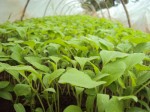Seed treatment – 8 steps towards healthy seedlings
Seed treatments are useful for many vegetable crops for the prevention of damping-off and some other root diseases, as well as eliminating certain diseases carried on the seed itself.
Seed treatment is not recommended for the inexperienced to used this type of method. It is easier to ask the seed supplier if the seed has been treated for various bacteria. The method used requires a heating system which can keep the water at a constant temperature of 55 °C, or whatever the setting required by the grower. The seed of crops such as eggplant, pepper, tomato, cucumber, carrot, spinach, lettuce, celery, cabbage, turnip, radish and other crucifers, can be treated effectively. The disadvantage of using hot water as seed treatment is that it causes seed injury. Seed of cucurbits can be severely damaged by hot-water treatment. The following procedure should be followed when using hot-water as a seed treatment the seed:
- Warm up water in a container, enough to hold the amount of seed to be treated.
- Insert any chemicals that are required, if any.
- Place the seed in a cotton bag and close the top of the bag
- Completely submerge the bag in the water
- Keep the seed in the water for the required time. Remember it should be exactly timed.
- After required time is over spread the seed out and allow to dry
- Allow at least 10 % extra seed initially since germination percentage will drop
- Never use old seed since they are easily injured by this type of treatment
The temperature of the water and duration of seed treatment varies according to vegetable type. Below is a list of water temperatures and seed treatment lengths:
- Brussels sprouts, cabbage, eggplant, spinach and tomato: 50°C for 25 minutes
- Broccoli, cauliflower, cucumber, carrot, collard, kale, kohlrabi, rutabaga and turnip: 50°C for 20 minutes.
- Mustard, cress and radish: 50°C for 15 minutes
- Pepper: 52°C at 30 minutes
- Lettuce, celery and celeriac: 48°C for 30 minutes.



